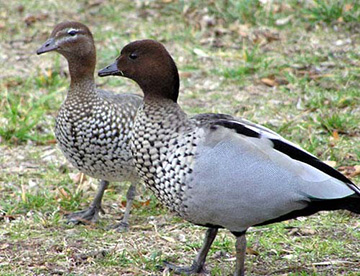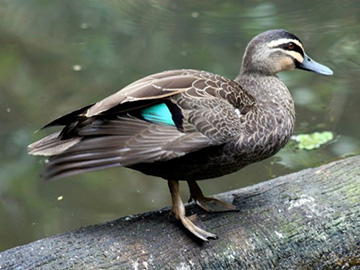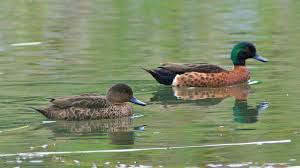Tom Parkinson's monthly column, introducing the diverse range of flora and fauna on show at Sanctuary Lakes.
Sanctuary Lakes has enjoyed above average warmth this autumn, unlike our northern cousins who have started winter with periods of heavy rain and flooding. Our first weeks of winter, although reasonably moist, have been mild in comparison. This difference has been noticed by our waterbirds and we have a seasonal upsurge in visiting ducks on our lake and ponds. Besides those we have already discussed like the Pink Eared Zebra Duck and the White Eyed Duck, there are three very common duck breeds that have become regular long term visitors. They are easily recognisable and can be seen on most days around the lake and possibly next month, breeding on its fringes and around the ponds. They are the Australian Wood Duck, the Pacific Black Duck and the Chestnut Teal.
 Female (left) and Male (right) Australian Wood Duck (Chenonetta jubata) The Australian Wood Duck, although 'duck size' is often called the Australian goose because its shape and characteristics are more similar to the goose. They spend a lot of their time grazing and feeding on the grassy banks, the golf course fringes of our Lake and fresh water ponds. It is rarely seen on the open water, preferring to forage in the shallows and will only take to open water when disturbed. Besides its goose-like features, the Wood Duck has a distinctive dark brown head and a pale grey body with two black stripes along the back. Males have the darker head and a small dark mane, with a speckled brown-grey breast and a black lower belly and under tail. The females have a paler head with two white stripes, above and below the eye, a speckled breast and flanks, with a white lower belly. They walk easily on land and are often seen on the golf course feeding in pairs.
Female (left) and Male (right) Australian Wood Duck (Chenonetta jubata) The Australian Wood Duck, although 'duck size' is often called the Australian goose because its shape and characteristics are more similar to the goose. They spend a lot of their time grazing and feeding on the grassy banks, the golf course fringes of our Lake and fresh water ponds. It is rarely seen on the open water, preferring to forage in the shallows and will only take to open water when disturbed. Besides its goose-like features, the Wood Duck has a distinctive dark brown head and a pale grey body with two black stripes along the back. Males have the darker head and a small dark mane, with a speckled brown-grey breast and a black lower belly and under tail. The females have a paler head with two white stripes, above and below the eye, a speckled breast and flanks, with a white lower belly. They walk easily on land and are often seen on the golf course feeding in pairs.
The Wood Duck forms monogamous breeding pairs that stay together year round. In Sanctuary Lakes and it's surround they tend to nests in tree holes, above or near water, often re-using the same site. Breeding can start as early as June through to October. Incubation takes about 28 days by the female while the male stands guard. Both parents feed the ducklings. After fledging, they are led away as a group to the lake or pond's edge and remain with their parents until the fly (about 50 days). Mortality among duckling appears high at approximately 70% until they are able to fly to safety.
 Pacific Black Duck (Anas superciliosa) The Pacific Black Duck anas suercilosa strangely is not black and its Latin name sounds like a Mary Poppins’s song! Unfortunately its repetitive raucous quack lacks the Poppins touch and its only black plumage is a bold stripe that runs across the bird’s face, from its bill to behind its eye, giving it an easily recognisable and distinctively striking pattern. Its back and body is a mid-brown in colour, with each feather edged buff. The upper wing colour is the same, but with a bright glossy green patch in the secondary flight feathers.
Pacific Black Duck (Anas superciliosa) The Pacific Black Duck anas suercilosa strangely is not black and its Latin name sounds like a Mary Poppins’s song! Unfortunately its repetitive raucous quack lacks the Poppins touch and its only black plumage is a bold stripe that runs across the bird’s face, from its bill to behind its eye, giving it an easily recognisable and distinctively striking pattern. Its back and body is a mid-brown in colour, with each feather edged buff. The upper wing colour is the same, but with a bright glossy green patch in the secondary flight feathers.
The Black Duck is one of the most versatile of the Australian ducks. It frequents both our Lake, ponds, creek and wetlands. They are usually seen in pairs and readily mix with other ducks.
Black Ducks are mainly vegetarian, feeding on seeds of aquatic plants, supplemented with small crustaceans, molluscs and aquatic insects. Food is obtained in the classic duck manner "dabbling", where the bird plunges its head and neck underwater and upends, raising its rear end vertically out of the water or "Bottoms Up".
Breeding season occurs when water areas are at their fullest and aquatic plants mature. They form seasonal pairs before breeding time starts. Nests range from scrapes in the ground to well-woven cups in grass or reeds, holes in trees stumps and in deserted nests of other water birds. The female plucks soft small feathers from her breast to cover the 7-13 smooth glossy white oval eggs. She will incubate the eggs for 26-30 days. Ducklings are semi-precocial - hatched with eyes open, covered with down, capable of walking/swimming soon after hatching but normally stay with the parents near the nest. Often, two broods are raised in a year. The number of offspring produced may seem quite high, but sadly only 20% will survive past two years of age.
 Chestnut Teal Anas castanea: female on the left of the male The male Chestnut Teal are distinctive and again easily recognisable, with their glossy green head, chestnut brown neck, breast and flanks, dark brown upper body and wings, and a black under tail with contrasting white patch. Females are mottled dark brown and grey, with a pale throat streaked brown and a dark eye stripe. In both the male and female the eye is a deep red, the bill is blue-grey and the legs and feet are green-grey.
Chestnut Teal Anas castanea: female on the left of the male The male Chestnut Teal are distinctive and again easily recognisable, with their glossy green head, chestnut brown neck, breast and flanks, dark brown upper body and wings, and a black under tail with contrasting white patch. Females are mottled dark brown and grey, with a pale throat streaked brown and a dark eye stripe. In both the male and female the eye is a deep red, the bill is blue-grey and the legs and feet are green-grey.
Another difference between the Chestnut Teal sexes is their quack. The female has a loud penetrating "laughing" quack repeated rapidly nine times or more, whereas the male has a single more muted sound.
The Chestnut Teal is one of the few ducks able to tolerate high salinity waters, although it still needs fresh water for drinking. Sanctuary Lakes is the perfect home with the large saline Lake and dotted with fresh water ponds and creek. The Chestnut Teal eats seeds, insects, molluscs and crustaceans along with some vegetation. It mainly feeds at the water's edge, but being a Duck it enjoys dabbling for food while swimming in the open water, up-ends to bottom feeding from out of the water weed.
Chestnut Teals form monogamous pairs that stay together outside the breeding season. Both parents choose and defend a nest site and the males stay with the female while she incubates the eggs. The nest is usually located near the water among clumps of grass, and are little more than a scrape, lined with down. Males do not assist with incubation but do look after the young when hatched. Sometimes 'dump-laying' occurs, where females leave their eggs in the nest of another female, which accounts for some large clutch sizes (up to 17 eggs in a nest). The young hatch ready to swim and walk within a day, and will move out with their mother on to the open water. Again mortality is high with as few as 25% surviving to their second year.
The natural predators of Wood, Black, and Chestnut Ducks, are harriers, falcons, and ravens from the air, musk ducks, purple swamphens and rakali from the water. Attacking off the land, foxes and worst of all, the feral domestic cats. If that's not enough, all three are listed game species for recreational hunting during the March to June season. This of course does not affect Sanctuary Lakes and its adjoining wetlands as all hunting of any type is forbidden.
Thanks to the large clutch sizes and the often second breeding, all three are still able to retain and even expand their flock sizes making their conservation status very secure. Which is a good "Spot' a Duck" news for the neighbourhood.